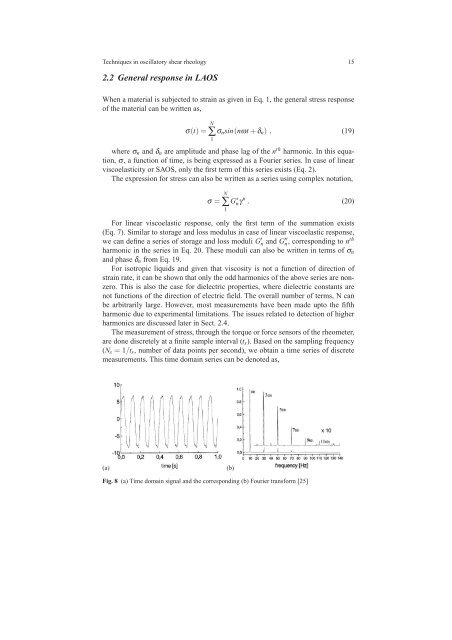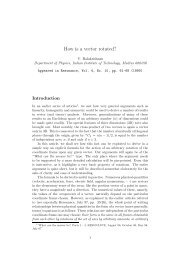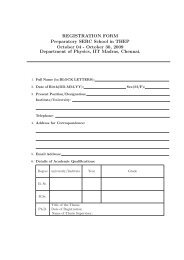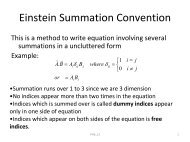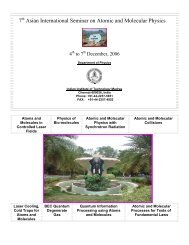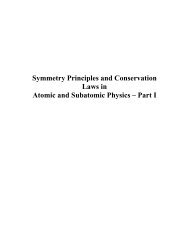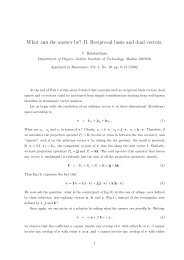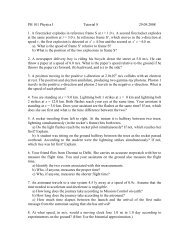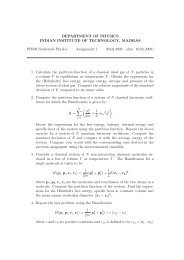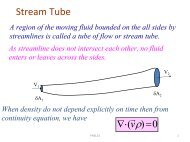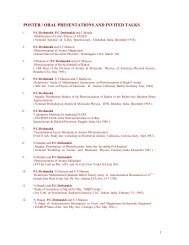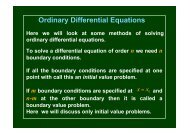Techniques in oscillatory shear rheology - Indian Institute of ...
Techniques in oscillatory shear rheology - Indian Institute of ...
Techniques in oscillatory shear rheology - Indian Institute of ...
Create successful ePaper yourself
Turn your PDF publications into a flip-book with our unique Google optimized e-Paper software.
<strong>Techniques</strong> <strong>in</strong> <strong>oscillatory</strong> <strong>shear</strong> <strong>rheology</strong> 152.2 General response <strong>in</strong> LAOSWhen a material is subjected to stra<strong>in</strong> as given <strong>in</strong> Eq. 1, the general stress response<strong>of</strong> the material can be written as,σ(t) =N∑1σ n s<strong>in</strong>(nωt + δ n ) , (19)where σ n and δ n are amplitude and phase lag <strong>of</strong> the n th harmonic. In this equation,σ, a function <strong>of</strong> time, is be<strong>in</strong>g expressed as a Fourier series. In case <strong>of</strong> l<strong>in</strong>earviscoelasticity or SAOS, only the first term <strong>of</strong> this series exists (Eq. 2).The expression for stress can also be written as a series us<strong>in</strong>g complex notation,σ =N∑1G ∗ nγ n . (20)For l<strong>in</strong>ear viscoelastic response, only the first term <strong>of</strong> the summation exists(Eq. 7). Similar to storage and loss modulus <strong>in</strong> case <strong>of</strong> l<strong>in</strong>ear viscoelastic response,we can def<strong>in</strong>e a series <strong>of</strong> storage and loss moduli G ′ n and G ′′n, correspond<strong>in</strong>g to n thharmonic <strong>in</strong> the series <strong>in</strong> Eq. 20. These moduli can also be written <strong>in</strong> terms <strong>of</strong> σ nand phase δ n from Eq. 19.For isotropic liquids and given that viscosity is not a function <strong>of</strong> direction <strong>of</strong>stra<strong>in</strong> rate, it can be shown that only the odd harmonics <strong>of</strong> the above series are nonzero.This is also the case for dielectric properties, where dielectric constants arenot functions <strong>of</strong> the direction <strong>of</strong> electric field. The overall number <strong>of</strong> terms, N canbe arbitrarily large. However, most measurements have been made upto the fifthharmonic due to experimental limitations. The issues related to detection <strong>of</strong> higherharmonics are discussed later <strong>in</strong> Sect. 2.4.The measurement <strong>of</strong> stress, through the torque or force sensors <strong>of</strong> the rheometer,are done discretely at a f<strong>in</strong>ite sample <strong>in</strong>terval (t s ). Based on the sampl<strong>in</strong>g frequency(N s = 1/t s , number <strong>of</strong> data po<strong>in</strong>ts per second), we obta<strong>in</strong> a time series <strong>of</strong> discretemeasurements. This time doma<strong>in</strong> series can be denoted as,(a)(b)Fig. 8 (a) Time doma<strong>in</strong> signal and the correspond<strong>in</strong>g (b) Fourier transform [25]


